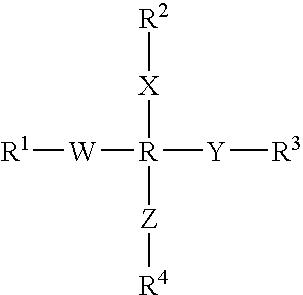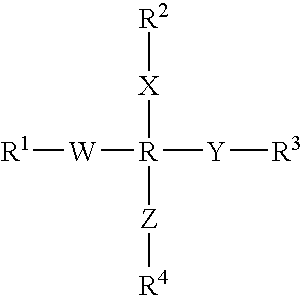Preparation, in particular cosmetic preparation, process for the...
a technology of cosmetic preparation and process, applied in the field of cosmetic preparation, can solve the problems of unpleasant irritation effects, oily veil on the lens, unpleasant effect of silicone use, etc., and achieve the effects of reducing mutual interactions, avoiding irritation, and avoiding greasy or sticky residu
- Summary
- Abstract
- Description
- Claims
- Application Information
AI Technical Summary
Benefits of technology
Problems solved by technology
Method used
Image
Examples
example 1
Cream Eyeshadow, Cooling (Non-Transfer)
[0061]
Decamethyl cyclopentasiloxane26.300Pentaerythrityl tetrabehenate5.900Cetyl PEG / PPG-10 / 1 dimethicone3.800Glycerine3.750Sodium chloride0.800Methylparaben0.200Propylparaben0.100Phenoxyethanol0.500Ascorbyl palmitate0.100Tocopherol0.350Fragrance0.300Titanated mica (C.I. No 77019, 77891)9.500Titanium dioxide (C.I. No 77891)3.500Red iron oxide (C.I. No 77491)1.000Yellow iron oxide (C.I. No 77492)0.600Black iron oxide (C.I. No 77499)0.400Aqua42.900
[0062] Production is effected by a procedure whereby the pigments are put with the silicone oil very intensively in a suitable homogenising machine with an anchor-type agitator and gear ring homogeniser and intensively dispersed by means of the homogeniser. Thereafter the tetrabehenyl tetrabehenate is added together with the emulsifier and melted at about 70-80° C. The parabens, phenoxyethanol, ascorbyl palmitate and tocopherol are now added to the melt. The glycerine and sodium chloride were dissolved...
example 2
Cream Eyeshadow, Cooling (Non-Transfer)
[0063]
Hexamethyl siloxane25.500Pentaerythrityl tetrabehenate4.600Sorbitan sesquioleate3.800Butane-1,3-diol3.500Titanated mica (C.I. 77019, 77891)15.500Ultramarine blue (C.I. 77013)5.800Chromium hydroxide green (C.I. 77289)1.200Black iron oxide (C.I. 77499)0.800Tocopherol0.500Fragrance0.150Methylparaben0.200Propylparaben0.150Ascorbyl palmitate0.100Magnesium sulphate0.700Aqua37.500
[0064] Production is effected similarly to the operating procedure described in Example 1. It will be appreciated that care is to be taken to ensure that the pearl pigment, as is familiar to the man skilled in the relevant art, is not exposed to severe shearing forces for too long. The result obtained is a water-resistant, workable paste which is blue with a green cast, with an excellent cooling effect and which can be well applied to the eyelids. The above preparation has a zero viscosity of 451,000 Pas. Experience has shown that somewhat different viscosity values ca...
example 3
Lip Rouge (Cooling, Water-Resistant)
[0065]
Hexamethyl disiloxane23.500Pentaerythrityl tetraerucate5.200Trioleyl phosphate4.100Butylene-1,3-glycol3.500Magnesium sulphate1.000Methylparaben0.200Propylparaben0.100Phenoxyethanol0.500Ascorbyl palmitate0.100Tocopherol0.300Fragrance0.150Titanated mica (C.I. No 77019, 77891)11.500Titanium dioxide (C.I. No 77891)2.800Red iron oxide (C.I. No 77491)2.200FD&C Yellow No 5 Al-Lake (C.I. 19140:1)0.800FD&C Red No 3 Al-Lake (C.I. 45430:1)0.700Aqua43.350
[0066] Production is effected similarly to the above-described mode of operation. The result obtained is a powerfully red preparation with a strong sheen, in the form of a water-resistant, workable paste with a zero viscosity of 491,000 Pas, which is particularly well suited for the automatic applicator devices described hereinbefore.
PUM
| Property | Measurement | Unit |
|---|---|---|
| Temperature | aaaaa | aaaaa |
| Temperature | aaaaa | aaaaa |
| Temperature | aaaaa | aaaaa |
Abstract
Description
Claims
Application Information
 Login to View More
Login to View More - R&D
- Intellectual Property
- Life Sciences
- Materials
- Tech Scout
- Unparalleled Data Quality
- Higher Quality Content
- 60% Fewer Hallucinations
Browse by: Latest US Patents, China's latest patents, Technical Efficacy Thesaurus, Application Domain, Technology Topic, Popular Technical Reports.
© 2025 PatSnap. All rights reserved.Legal|Privacy policy|Modern Slavery Act Transparency Statement|Sitemap|About US| Contact US: help@patsnap.com


